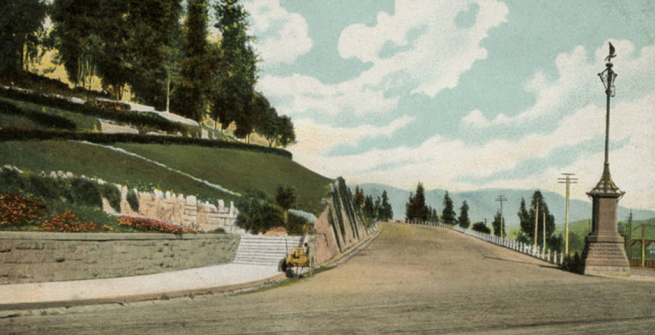Friday is National Arbor Day: a day to celebrate trees. When we look around Los Angeles today with its beautiful tree-filled parks and palm-lined streets, it's hard to imagine it being any different. But when Los Angeles was first settled, it was a landscape mostly devoid of trees, with only chaparral and scrub as far as the eye could see. The four species of trees that made up the landscape were relegated to coastal regions and waterways: Coastal Live Oak, California Sycamore, California Bay, and California Black Walnut.
But as the area became settled, a leafier Los Angeles eventually emerged. Like our fair city's denizens, much of our trees and flora were transplants, and the species we think of as natives came from elsewhere. Our collection of palm trees? We have Mexico and the Canary Islands to thank! Bougainvillea, oranges, and Jacarandas? All are from South America (mainly Brazil). Our Eucalyptus trees are from Australia.
Elysian Park, the oldest and among the largest of our parks, rose up in much the same way: transplanted and random. The area was originally 550 acres of scrubby hills and ravines. At some point, it was a rock quarry and older maps show a Jewish cemetery as well. What few trees had grown there were long gone to firewood and house building, and the area was considered unattractive and unsuitable for much. The land was purchased on the cheap to become parkland, the only thing they could think do with the expanse. The mayor at the time, Henry Hazard, personally led the charge to beautify the park and make it something the city's citizens could enjoy. "Between 1886 and 1892, the city parks commission and private groups together planted more than 150,000 trees—a number mostly accounted for by inexpensive eucalypts but also including deodar cedars, live oaks, pines, cypresses, and pepper trees." As the landscape grew and changed, many amenities were added, like restrooms, footpaths, campgrounds, and a grand entrance. "The park became even more colorful in 1893 when the Los Angeles Horticultural Society created the City Arboretum in Chavez Ravine. A haphazard planting of rare trees from around the world, the arboretum transformed Elysian Park's western canyon into an exotic forest." There remain 138 identifiable varieties still standing today which you can visit and marvel at.
The park eventually became a welcome retreat from the ever-growing sprawl of the city, and is still a favorite spot to hike, picnic, fly kites and gaze at what most of us think of as "our" trees.
Enjoy these photos and maps from our collection highlighting this unique arboreal area.
This early map (listed as Official Map no.4) shows an Israelite Cemetery and a Roman Catholic Cemetery just outside of the ravines.
1884 surveyors map separating the ravines into Chavez Ravine, Sulphur Ravine, Cemetery Ravine, Solano Ravine and Reservoir Ravine. The Hebrew Cemetery appears on this map, but not Calvary.
This map shows the park divided into numbered sections as in the 1884 map, and includes the owners for each segment. Two separate cemeteries are depicted here, Hebrew Cemetery and Calvary Cemetery.
This not totally to scale map from 1909 shows Elysian Park seemingly on the outskirts of town.
Both cemeteries are gone from the 1918 map, and Echo Park Lake has been added. The squiggles depicting parkland are visible for both Echo and Elysian Parks.
Topographical map showing three separate reservoirs in the park.


















